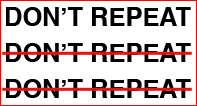After working hard on an article and attracting visitors to your site, the last thing you want them to do is leave without reading anything! After all, you’ve spent your time and put in a lot of effort on that article. You want your visitors to read it, enjoy it and maybe learn something from it!
Tapping into my blog-reading and writing experiences, I’ve compiled a list of things that will help you create a post that won’t encourage interested readers to leave your blog once they get there. After advising you how to lay the foundation of your article in Part I, I will focus on the finishing touches of your post in Part II today.
Make it easy to read: Design matters. If readers see big blocks of text, they will run away without even reading a single sentence. Wouldn’t you? Readers perceive paragraphs that go on forever as unmanageable. Unmanageable means that it feels like work to read the article. No one wants to work if they don’t have to. Make it easy on your readers. They’ll thank you by coming back or sharing your article.
 Ensure each sentence adds value: Make sure that each sentence and paragraph adds value to post. As a general rule, don’t repeat yourself, especially if you have a tendency to be long winded in your writing.
Ensure each sentence adds value: Make sure that each sentence and paragraph adds value to post. As a general rule, don’t repeat yourself, especially if you have a tendency to be long winded in your writing.
I was reading an article the other day, and the author started the post with a summary of current conditions. Judging from the headline, I thought he was going to analyze these conditions, but he only summarized them again three paragraphs later. He was repetitive and offered no analysis. At that point, I left the page. He might have had valuable information after that, but I wasn’t going to stick around to find out.
Choose an appropriate headline: There are many schools of thought when it comes to writing a headline (i.e. before vs. after you write the draft), but the important thing is to make it accurate. You can still write creative headlines that pique interest and are accurate. If your site gets a reputation for misleading or over-promising headlines, you will eventually see the effects in your web traffic. And your reputation will not be good (nor will your traffic!).
Include graphics: Again, design matters. Humans are visual. You don’t want to see a web page of only text. How boring! Liven up your post with a relevant picture or two from Flickr, but make sure that you have permission to use the photo.
Include a call to action: Create a call to action at the end to entice comments and conversation about your topic. Ask a question or welcome naysayers to express their thoughts. Or tell you reader what to do next. Link to other articles if it is a multi-part series.

Sit on it for a day: You’re finished writing, you’re excited and you want to post it on your site. Stop right there. You need to follow the Rule of 24 from Larry Brooks. Nobody likes to follow rules, but look at it as a guaranteed way to improve your writing.
The Rule of 24 is simple. After writing your final draft, wait 24 hours before looking over it one last time and submitting it. You’ll change something, and that change will improve the article. This also gives you one last chance to objectively look at your article and spot places where you go off topic. Obviously, you can’t follow the rule of 24 if you have time-sensitive news, but you should take advantage of it if you have the opportunity.
Do you think I missed anything? Did you want to keep reading or did I lose you somewhere?
Photo courtesy of glasgows/Flickr